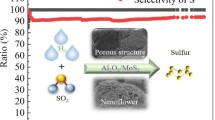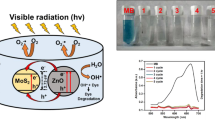Abstract
A nano-MoS2/TiO2 composite was synthesized in H2 atmosphere by calcining a MoS3/TiO2 precursor, which was obtained via a quick deposition of MoS3 on anatase nano-TiO2 under a strong acidic condition. The obtained nano-MoS2/TiO2 composite was characterized by X-ray diffraction spectroscopy, Brunauer–Emmett–Teller (BET) surface area, scanning electron microscopy, high-resolution transmission electron microscopy, energy-dispersive spectrometry, ultraviolet–visible spectroscopy, and Fourier transform infrared spectroscopy. The results show that the composite had a high BET surface area because of its small size and irregularly layered structure. MoS2 in the composite was composed of typical layered structures with thicknesses of 2–8 nm and lengths of 10–40 nm. The composite contained a wide and intensive absorption at 400–700 nm, which is in the visible light region, and presented a positive catalytic effect on removing methyl orange from the aqueous solution. The catalytic activity of the composite was influenced by the initial concentration of methyl orange, the amount of the catalyst, the pH value, and the degradation temperature. In addition, the composite catalyst could be regenerated and repeatedly used via filtration three times. The deactivating catalyst could be reactivated after catalytic reaction by heating at 450 °C for 30 min in H2.









Similar content being viewed by others
References
Valyon J, Hall WK (1983) J Catal 84:216
Richardson JT (1988) J Catal 112:313
Millman WS, Segawa K, Smrz D, Hall WK (1986) Polyhedron 5:169
Moore SE, Lunsford JH (1982) J Catal 77:297
Faye P, Payen E, Bougeard D (1999) J Mol Model 5:63
Daage M, Chianelli RR (1994) J Catal 149:414
Miremadi BK, Morrison SR (1987) J Catal 103:334
Miremadi BK, Morrison SR (1988) J Catal 112:418
Peng YY, Meng ZY, Zhong C, Lu J, Yang ZP, Qian YT (2002) Mater Chem Phys 73:327
Zhan JH, Zhang ZD, Qian XF, Wang C, Xie Y, Qian YT (1998) J Solid State Chem 141:270
Li WJ, Shi EW, Ko JM, Chen ZZ, Ogino H, Fukuda T (2003) J Cryst Growth 250:418
Li XL, Li YD (2004) J Phys Chem B 108:13893
Wilcoxon JP, Newcomer PP, Samara GA (1997) J Appl Phys 81:7934
Afanasiev P, Xia GF, Berhault G, Jouguet B (1999) Chem Mater 11:3216
Feldman Y, Wasserman E, Srolovitz DJ, Tenne R (1995) Science 267:222
Zach MP, Inazu K, Ng KH, Hemmingr JC, Penner RM (2002) Chem Mater 14:3206
Nath M, Govindaraj A, Rao CNR (2001) Adv Mater 13:283
Zou TZ, Tu JP, Huang HD, Lai DM, Zhang LL, He DN (2006) Adv Eng Mater 8:289
Hu KH, Wang YR, Hu XG, Wo HZ (2007) Mater Sci Technol 23:242
Hu KH, Hu XG (2009) Mater Sci Technol 25:407
Chatterjee D, Mahata A (2002) J Photochem Photobiol A 153:199
Min SX, Wang F, Han YQ (2007) J Mater Sci 42:9966. doi:10.1007/s10853-007-2074-z
Randeniya LK, Murphy AB, Plumb IC (2008) J Mater Sci 43:1389. doi:10.1007/s10853-007-2309-z
Castro AL, Nunes MR, Carvalho AP, Costa FM, Florêncio MH (2008) Solid State Sci 10:602
Reddy BM, Reddy GK, Rao KN, Ganesh I, Ferreira JMF (2009) J Mater Sci 44:4874. doi:10.1007/s10853-009-3743-x
Jiang BT, Zhang SY, Guo XZ, Jin BK, Tian YP (2009) Appl Surf Sci 255:5975
Iliev V, Prahov L, Bilyarska L, Fischer H, Schulz-Ekloff G, Wöhrle D, Petrov L (2000) J Mol Catal A 151:161
Tributsch H (1977) Z Naturforsch 32a:972
Pelizzetti E, Visca M (1983) In: Gratzel M (ed) Energy resources through photochemistry and catalysis. Academic Press, New York, p 261
Thurston TR, Wilcoxon JP (1999) J Phys Chem B 103:11
Ho WK, Yu JC, Lin J, Yu JG, Li PS (2004) Langmuir 20:5865
Wilcoxon JP, Thurston TR, Martin JE (1999) Nanostruct Mater 12:993
Pourabbas B, Jamshidi B (2008) Chem Eng J 138:55
Shimada H (2003) Catal Today 86:17
Kam KK, Parkinson BA (1982) J Phys Chem 86:463
Huang JM, Laitinen RA, Kelley DF (2000) Phys Rev B 62:10995
Wilcoxon JP (2000) J Phys Chem B 104:7334
Baiocchi C, Brussino MC, Pramauro E, Prevot AB, Palmisano L, Marcì G (2002) Int J Mass Spectrom 214:247
Acknowledgements
The financial support from the National Key Technology R&D Program of China (Grant No. 2007BAD34B02), National Natural Science Foundation of China (Grant No. 50905054), Anhui Provincial Natural Science Foundation (Grant No. 070414152), and Anhui Provincial Foundation for Excellent Young Talents in University (Grant No. 2010SQRL160) is highly appreciated.
Author information
Authors and Affiliations
Corresponding author
Rights and permissions
About this article
Cite this article
Hu, K.H., Hu, X.G., Xu, Y.F. et al. Synthesis of nano-MoS2/TiO2 composite and its catalytic degradation effect on methyl orange. J Mater Sci 45, 2640–2648 (2010). https://doi.org/10.1007/s10853-010-4242-9
Received:
Accepted:
Published:
Issue Date:
DOI: https://doi.org/10.1007/s10853-010-4242-9




